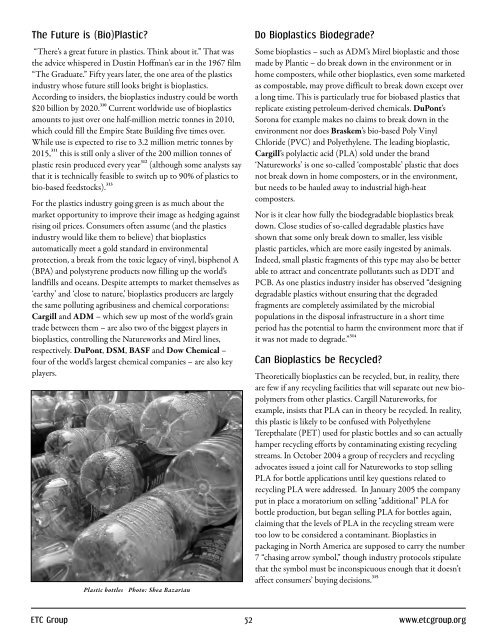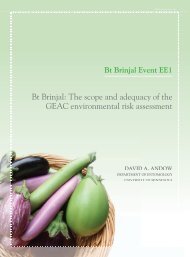Bio-based Building BlocksIn particular, synthetic biologists and chemists are attemptingto manufacture what they call ‘platform chemicals’ from asugar or biomass feedstock. These are key building blockchemicals that can in turn be refined into hundreds of otheruseful chemicals currently being produced in commercialrefineries. Commercial petrochemistry already takes thisapproach, cracking petroleum into essential building blockssuch as ethylene, butadiene, propylene and xylene and flexibleintermediates such as ammonia, acetic acid, carbolic acid andbutylene for refinement into thousands more. By targetingthese key platform chemicals or choosing new ones, chemistsdeveloping biobased substances are able to convert tens orhundreds of chemicals at one time from fossil carbon to plantcarbon. Examples of bio-based platform chemicals nowcoming to market include:Isoprenoids or terpenoids are a class of naturally occurringcompounds including rubber, taxol, neem, artemisinin andcannabinoids. Some of these have been produced in syntheticyeast by Amyris Biotechnologies, Inc. Amyris has focused onone isoprenoid called farnesene (which produces the acridsmell in apples), which they claim can be further refined into“a wide range of products varying from specialty chemicalapplications such as detergents, cosmetics, perfumes andindustrial lubricants, to transportation fuels such as diesel.” 299Amyris, whose synthetic yeast currently munch on Braziliancane sugar have an agreement with Procter &Gamble 300 toturn farnesene into cosmetics and household products. Theyhave a further agreement with M&G Finanziaria, the worlds’largest supplier of plastic for packaging bottles to use biobasedfarnesene in production of PET plastic. 301Genencorhas also engineered synthetic E. coli to produce isoprene usedfor rubber production. In 2008 they partnered with global tiremanufacturer Goodyear, Inc. to produce industrial quantitiesof tire rubber. They claim their ‘bioisoprene’ replaces theseven gallons of crude oil currently required to make onesynthetic rubber tire. 3021,3-Propanediol is a building block chemical that can be usedfor plastics, composites, adhesives, laminates, coatings and as asolvent in antifreeze and wood paint. Although usuallyproduced from ethylene oxide (a petroleum derivative), it hasnow been produced by Genencor in synthetic yeast as Bio-PDO, a precursor for DuPont’s bioplastic Sorona. DuPont, inpartnership with Tate & Lyle, currently produces 45,000tonnes per year of Bio PDO at its plant in Loudon, Tennessee,USA annually consuming 152,000 tonnes of corn (covering anarea of about 40,000 acres – roughly the size ofLiechtenstein). 303In June 2010, DuPont announced a 35% expansion ofproduction. 304 French bio-based products company,METabolic EXplorer also makes Bio-PDO, converted fromglycerol, a plant oil. The company estimates the global PDOmarket will reach 1.3 billion Euros by 2020. 305Succinic acid is a naturally occurring by-product of sugarfermentation that is a close chemical cousin to maleicanhydride – a petroleum-derived chemical used as a commonfeedstock for food and pharmaceutical products, surfactants,de-icers, coolants, detergents, plastics, pesticides, clothingfibres, and biodegradable solvents. Since it is possible totransform succinic acid into maleic anhydride, a number offirms are now competing to produce large quantities ofsuccinic acid, chasing a market that could be worth $2.5billion per year. 306 Those developing bio-based succinic acidinclude DSM and Mitsubishi Chemicals. BASF and Puracare developing a succinic acid plant in Spain and a 2000 tonneper year plant is already operational in Pomacle, France, usingmutant E. coli bacteria to produce succinic acid from wheatsugars. The plant is run by Bioamber – a joint venture of U.S.biotech company DNP and ARD (France’s Agro-industrieRecherches et Developpements). 307 In 2010 U.S.-basedsynthetic biology company Myriant received a $50 milliongrant from the U.S. Department of Energy to build a 14,000tonne bio-succinic acid plant in Louisiana. 308Ethylene is the gaseous raw material used in the manufactureof plastics including polyethylene (PE), polyester, polyvinylchloride (PVC) and polystyrene, as well as fibres and otherorganic chemicals. Usually made from naptha or natural gas,ethylene can also be made as a byproduct of ethanolproduction. Indeed in the 1980s Brazilian companiesproduced 160,000 tonnes of PVC and polyethylene (PE) fromethanol until world oil prices fell and the plants were closeddown. In 2008 three separate chemical companies, Braskem,Solavay and Dow Chemical, all announced they wouldrestart production of bio-based PVC and PE in Brazil andArgentina from sugarcane amounting to 860,000 tonnes peryear. 309Other companies to watch that are using chemistry andsynthetic biology to create bio-based chemicals and plasticsinclude:ADM/ Metabolix, BASF, Blue Marble, CargillNatureworks, Codexis, Draths Corporation, DSM,DuPont, Genomatica, LS9, OPX Biotechnologies, Segetis,Solazyme, Qteros and Zeachem.The New Biomassters 51
The Future is (Bio)Plastic?“There’s a great future in plastics. Think about it.” That wasthe advice whispered in Dustin Hoffman’s ear in the 1967 film“The Graduate.” Fifty years later, the one area of the plasticsindustry whose future still looks bright is bioplastics.According to insiders, the bioplastics industry could be worth$20 billion by 2020. 310 Current worldwide use of bioplasticsamounts to just over one half-million metric tonnes in 2010,which could fill the Empire State Building five times over.While use is expected to rise to 3.2 million metric tonnes by2015, 311 this is still only a sliver of the 200 million tonnes ofplastic resin produced every year 312 (although some analysts saythat it is technically feasible to switch up to 90% of plastics tobio-based feedstocks). 313For the plastics industry going green is as much about themarket opportunity to improve their image as hedging againstrising oil prices. Consumers often assume (and the plasticsindustry would like them to believe) that bioplasticsautomatically meet a gold standard in environmentalprotection, a break from the toxic legacy of vinyl, bisphenol A(BPA) and polystyrene products now filling up the world’slandfills and oceans. Despite attempts to market themselves as‘earthy’ and ‘close to nature,’ bioplastics producers are largelythe same polluting agribusiness and chemical corporations:Cargill and ADM – which sew up most of the world’s graintrade between them – are also two of the biggest players inbioplastics, controlling the Natureworks and Mirel lines,respectively. DuPont, DSM, BASF and Dow Chemical –four of the world’s largest chemical companies – are also keyplayers.Plastic bottles Photo: Shea BazarianDo Bioplastics Biodegrade?Some bioplastics – such as ADM’s Mirel bioplastic and thosemade by Plantic – do break down in the environment or inhome composters, while other bioplastics, even some marketedas compostable, may prove difficult to break down except overa long time. This is particularly true for biobased plastics thatreplicate existing petroleum-derived chemicals. DuPont’sSorona for example makes no claims to break down in theenvironment nor does Braskem’s bio-based Poly VinylChloride (PVC) and Polyethylene. The leading bioplastic,Cargill’s polylactic acid (PLA) sold under the brand‘Natureworks’ is one so-called ‘compostable’ plastic that doesnot break down in home composters, or in the environment,but needs to be hauled away to industrial high-heatcomposters.Nor is it clear how fully the biodegradable bioplastics breakdown. Close studies of so-called degradable plastics haveshown that some only break down to smaller, less visibleplastic particles, which are more easily ingested by animals.Indeed, small plastic fragments of this type may also be betterable to attract and concentrate pollutants such as DDT andPCB. As one plastics industry insider has observed “designingdegradable plastics without ensuring that the degradedfragments are completely assimilated by the microbialpopulations in the disposal infrastructure in a short timeperiod has the potential to harm the environment more that ifit was not made to degrade.” 314Can Bioplastics be Recycled?Theoretically bioplastics can be recycled, but, in reality, thereare few if any recycling facilities that will separate out new biopolymersfrom other plastics. Cargill Natureworks, forexample, insists that PLA can in theory be recycled. In reality,this plastic is likely to be confused with PolyethyleneTerepthalate (PET) used for plastic bottles and so can actuallyhamper recycling efforts by contaminating existing recyclingstreams. In October 2004 a group of recyclers and recyclingadvocates issued a joint call for Natureworks to stop sellingPLA for bottle applications until key questions related torecycling PLA were addressed. In January 2005 the companyput in place a moratorium on selling “additional” PLA forbottle production, but began selling PLA for bottles again,claiming that the levels of PLA in the recycling stream weretoo low to be considered a contaminant. Bioplastics inpackaging in North America are supposed to carry the number7 “chasing arrow symbol,” though industry protocols stipulatethat the symbol must be inconspicuous enough that it doesn’taffect consumers’ buying decisions. 315ETC Group 52 www.etcgroup.org











